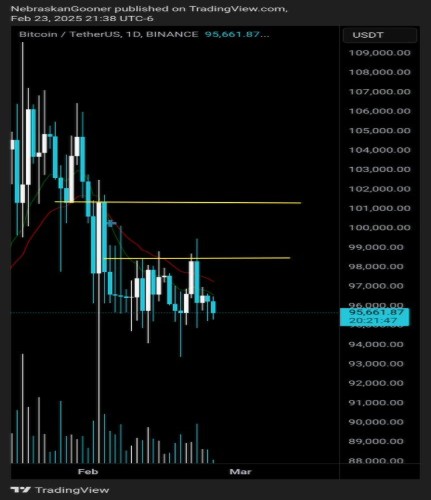Bitcoin continues to hover near $96,000, caught in a tightening trading range as volatility plummets to multi-year lows. While past instances of similar price compression have often preceded sharp breakouts, the market remains uncertain about whether the next move will be up or down.
Traders are watching closely, analyzing key support and resistance levels, as well as institutional buying trends, to determine Bitcoin’s next direction.
Bitcoin’s Volatility Sinks to Historic Lows
Bitcoin’s price action has been remarkably stable despite recent market events, including a $1.5 billion hack at cryptocurrency exchange Bybit. Data from Glassnode shows Bitcoin’s one-week realized volatility has dropped to 23.42%, a level not seen since late 2024. Historically, such extreme compression in volatility has been a precursor to significant market moves, often leading to either a rapid surge or a steep decline.
BTC/USD remains locked between critical technical levels. It has found support near $93,388 while facing resistance at the 50-day simple moving average of $98,933. The 20-day exponential moving average, currently at $97,236, is sloping downward, signaling slight bearish momentum.
Analysts caution that a breakdown below $92,000 could see Bitcoin retesting the $85,000 level, while a decisive move above $106,000 could trigger renewed price discovery.
Institutional Buying Signals Strength
Institutional investors continue to accumulate Bitcoin despite the subdued price action. Strategy—formerly known as MicroStrategy—has expanded its holdings, now owning 478,740 BTC, worth nearly $46 billion. The company recently completed a $2 billion convertible note offering to fund further acquisitions, demonstrating long-term confidence in Bitcoin’s value.
BlackRock has also increased its stake in Strategy to 5%, highlighting growing institutional interest in Bitcoin exposure. Meanwhile, multiple U.S. pension funds, led by California’s teachers’ retirement fund with an $83 million investment in Strategy shares, maintain indirect Bitcoin exposure. These moves underscore the belief among major investors that Bitcoin remains a strong store of value despite recent market stagnation.
Market Reactions and Analyst Projections
Bitcoin’s latest downturn was exacerbated by the Bybit hack, where nearly 401,000 Ethereum was stolen. The incident triggered a surge in withdrawals as users rushed to secure their assets. Bybit CEO Ben Zhou reassured investors of the platform’s solvency, but the breach has added to market uncertainty.
On the technical front, prominent analysts remain divided on Bitcoin’s immediate trajectory. Twitter analyst @Nebraskangooner suggests that BTC must reclaim $98,500 to build upside momentum, while a drop below $95,500 could invite further selling pressure. Meanwhile, @TitanofCrypto notes that Bitcoin dominance may weaken in the coming weeks, potentially boosting altcoin markets.

FriedrichBTC, another market observer, describes the current range as a “no-trade zone” due to the lack of clear direction. He notes that while institutional buying remains strong, leveraged traders are holding off until a more definitive price movement emerges.
What Comes Next?
With trading volumes and open interest at their lowest levels since early February, Bitcoin is approaching a critical juncture. If BTC can breach the psychological $100,000 level, traders may shift focus to the next major resistance at $102,500.
However, failure to hold support above $92,000 could accelerate downward pressure toward the $90,000 mark.
Institutional adoption continues to provide a bullish long-term outlook, with ARK Invest CEO Cathie Wood reiterating her projection of Bitcoin reaching $1.5 million by 2030. But in the short term, all eyes are on whether Bitcoin’s low volatility environment will snap, leading to a breakout or a deeper correction.





